Soyuz TM-19
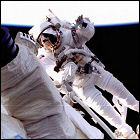 Soyuz TM-19 lifts off from Kazakhstan, on a mission to the Russian space station Mir with cosmonauts Yuri Malenchenko and Talgat Musabayev aboard. Over the course of their 125-day stay, the crew joins Dr. Valery Polyakov aboard Mir, in the middle of his record-shattering 437-day stay in space. Malenchenko and Musabayev conduct 11 hours worth of spacewalks to repair Mir’s exterior insulation and other minor maintenance, and returns home in November 1994 with German astronaut Ulf Merbold.
Soyuz TM-19 lifts off from Kazakhstan, on a mission to the Russian space station Mir with cosmonauts Yuri Malenchenko and Talgat Musabayev aboard. Over the course of their 125-day stay, the crew joins Dr. Valery Polyakov aboard Mir, in the middle of his record-shattering 437-day stay in space. Malenchenko and Musabayev conduct 11 hours worth of spacewalks to repair Mir’s exterior insulation and other minor maintenance, and returns home in November 1994 with German astronaut Ulf Merbold.
STS-59
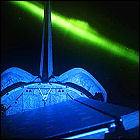 NASA launches Space Shuttle Endeavour on an 11-day mission to carry the Space Radar Laboratory experiment into orbit. The radar systems map sites on Earth and test other applications for orbital radar. Aboard Endeavour for her sixth flight are Commander Sidney Gutierrez, Pilot Kevin Chilton, Payload Commander Linda Godwin, and mission specialists Jay Apt, Michael Clifford and Thomas Jones.
NASA launches Space Shuttle Endeavour on an 11-day mission to carry the Space Radar Laboratory experiment into orbit. The radar systems map sites on Earth and test other applications for orbital radar. Aboard Endeavour for her sixth flight are Commander Sidney Gutierrez, Pilot Kevin Chilton, Payload Commander Linda Godwin, and mission specialists Jay Apt, Michael Clifford and Thomas Jones.
STS-62
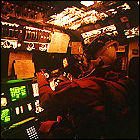 Space Shuttle Columbia lifts off on the 61st shuttle mission, a two-week visit to Earth orbit carrying two cargo-bay-mounted experiment systems operated primarily from the ground. Crew members participate in experiments involving the side-effects of long-term space travel. The crew for Columbia’s 16th flight consists of Commander John Casper, Pilot Andrew Allen, and mission specialists Pierre Thuot, Charles Gemar and Marsha Ivins.
Space Shuttle Columbia lifts off on the 61st shuttle mission, a two-week visit to Earth orbit carrying two cargo-bay-mounted experiment systems operated primarily from the ground. Crew members participate in experiments involving the side-effects of long-term space travel. The crew for Columbia’s 16th flight consists of Commander John Casper, Pilot Andrew Allen, and mission specialists Pierre Thuot, Charles Gemar and Marsha Ivins.
STS-60
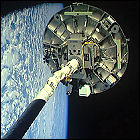 Space Shuttle Discovery lifts off on the 60th flight of the shuttle program. During its eight days in orbit, Discovery hosts the first Russian cosmonaut ever to fly aboard an American spacecraft, initiating an ongoing agreement between the two countries’ space agencies that will eventually lead to shuttles visiting Mir and the construction of the International Space Station. Aboard Discovery for her 18th flight are Commander Charles Bolden, Pilot Kenneth Reightler, and mission specialists Jan Davis, Ronald Sega, Franklin Chang-Diaz and Sergei Krikalev.
Space Shuttle Discovery lifts off on the 60th flight of the shuttle program. During its eight days in orbit, Discovery hosts the first Russian cosmonaut ever to fly aboard an American spacecraft, initiating an ongoing agreement between the two countries’ space agencies that will eventually lead to shuttles visiting Mir and the construction of the International Space Station. Aboard Discovery for her 18th flight are Commander Charles Bolden, Pilot Kenneth Reightler, and mission specialists Jan Davis, Ronald Sega, Franklin Chang-Diaz and Sergei Krikalev.
A close call at Mir
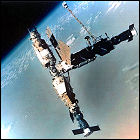 The departing crew of Soyuz TM-17, cosmonauts Vasili Tsibliyev and Aleksandr Serebrov, board their capsule and vacate the Russian Mir space station, as planned. Ordered to take photos of the new docking assembly that will someday allow American space shuttles to visit Mir, Tsibliyev brings the Soyuz back to a close distance from the station, but complains of sluggish controls – just before Soyuz collides with the station, bouncing off of its outer hull twice. Mir’s newly arrived crew prepares to evacuate in their own Soyuz, but no critical damage is found to either the station or to Soyuz TM-17, which is allowed to return home. Tsibliyev’s luck aboard Mir will only get worse during his troubled second tour of duty on the station later in the 1990s.
The departing crew of Soyuz TM-17, cosmonauts Vasili Tsibliyev and Aleksandr Serebrov, board their capsule and vacate the Russian Mir space station, as planned. Ordered to take photos of the new docking assembly that will someday allow American space shuttles to visit Mir, Tsibliyev brings the Soyuz back to a close distance from the station, but complains of sluggish controls – just before Soyuz collides with the station, bouncing off of its outer hull twice. Mir’s newly arrived crew prepares to evacuate in their own Soyuz, but no critical damage is found to either the station or to Soyuz TM-17, which is allowed to return home. Tsibliyev’s luck aboard Mir will only get worse during his troubled second tour of duty on the station later in the 1990s.
Soyuz TM-18
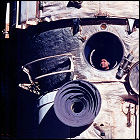 Russian spacecraft Soyuz TM-18 lifts off from Baikonur Cosmodrome in Kazakhstan, on a mission to the Russian space station Mir. Aboard the Soyuz are cosmonauts Viktor Afanasyev, Yuri Usachov, and Dr. Valeri Polyakov, a medical doctor who will study the effects of long-duration spaceflight on the crew (including himself). Following a scary close call with the previous crew’s wayward Soyuz, the TM-18 crew settles in for a 182-day stay, with Afanasyev and Usachov returning to Earth; Polyakov remains aboard Mir, where he will eventually set the human space endurance record with a 420-day stay in orbit.
Russian spacecraft Soyuz TM-18 lifts off from Baikonur Cosmodrome in Kazakhstan, on a mission to the Russian space station Mir. Aboard the Soyuz are cosmonauts Viktor Afanasyev, Yuri Usachov, and Dr. Valeri Polyakov, a medical doctor who will study the effects of long-duration spaceflight on the crew (including himself). Following a scary close call with the previous crew’s wayward Soyuz, the TM-18 crew settles in for a 182-day stay, with Afanasyev and Usachov returning to Earth; Polyakov remains aboard Mir, where he will eventually set the human space endurance record with a 420-day stay in orbit.
STS-61: new eyes for Hubble
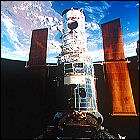 NASA launches Space Shuttle Endeavour on a ten-day mission to retrieve and repair the Hubble Space Telescope, which was launched in 1990 with flawed optics. With the $2,000,000,000 telescope held steady in the cargo bay, Endeavour astronauts conduct repairs during spacewalks totaling over 35 hours of the mission, before releasing Hubble back into orbit with new eyes. Aboard Endeavour for her history-making fifth flight are Commander Richard Covey, Pilot Kenneth Bowersox, Payload Commander Story Musgrave, and mission specialists Kathryn Thornton, Claude Nicollier, Jeffrey Hoffman and Tom Akers.
NASA launches Space Shuttle Endeavour on a ten-day mission to retrieve and repair the Hubble Space Telescope, which was launched in 1990 with flawed optics. With the $2,000,000,000 telescope held steady in the cargo bay, Endeavour astronauts conduct repairs during spacewalks totaling over 35 hours of the mission, before releasing Hubble back into orbit with new eyes. Aboard Endeavour for her history-making fifth flight are Commander Richard Covey, Pilot Kenneth Bowersox, Payload Commander Story Musgrave, and mission specialists Kathryn Thornton, Claude Nicollier, Jeffrey Hoffman and Tom Akers.
STS-58
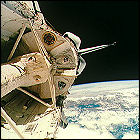 Space Shuttle Columbia is launched on the 58th shuttle mission, a two-week stay in orbit with the Spacelab module. This is the second Spacelab flight devoted to medical experiments and life sciences. Aboard Columbia for her 15th flight are Commander John Blaha, Pilot Richard Searfoss, mission specialists Rhea Seddon, William McArthur, David Wolf and Shannon Lucid, and payload specialist Martin Fettman.
Space Shuttle Columbia is launched on the 58th shuttle mission, a two-week stay in orbit with the Spacelab module. This is the second Spacelab flight devoted to medical experiments and life sciences. Aboard Columbia for her 15th flight are Commander John Blaha, Pilot Richard Searfoss, mission specialists Rhea Seddon, William McArthur, David Wolf and Shannon Lucid, and payload specialist Martin Fettman.
STS-51
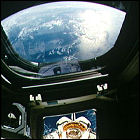 Space Shuttle Discovery lifts off on the 57th shuttle mission, a nine-day stay in orbit to release a communications satellite and test a new second stage engine designed to push that satellite into geosynchronous orbit. A free-floating ultraviolet spectography experiment is released from the shuttle’s cargo bay and retrieved before the end of the mission, and spacewalking techniques for the upcoming Hubble Space Telescope repair mission are practiced. Aboard Discovery for her 17th flight are Commander Frank Culbertson Jr., Pilot William Readdy, and mission specialists James Newman, Daniel Bursch and Carl Walz.
Space Shuttle Discovery lifts off on the 57th shuttle mission, a nine-day stay in orbit to release a communications satellite and test a new second stage engine designed to push that satellite into geosynchronous orbit. A free-floating ultraviolet spectography experiment is released from the shuttle’s cargo bay and retrieved before the end of the mission, and spacewalking techniques for the upcoming Hubble Space Telescope repair mission are practiced. Aboard Discovery for her 17th flight are Commander Frank Culbertson Jr., Pilot William Readdy, and mission specialists James Newman, Daniel Bursch and Carl Walz.
Soyuz TM-17
 The Russian spacecraft Soyuz TM-17 lifts off from Kazakhstan, bound for space station Mir. Cosmonauts Vasili Tsibliyev, Aleksandr Serebrov replace the incumbent station crew, staying aboard Mir for 196 days, while Jean-Pierre Haigneré returns to Earth with the previous Mir crew aboard Soyuz TM-16 after a three-week stay. When the crew leaves Mir in January 1994, their departure is anything but routine, as Tsibliyev is unable to prevent a collision between Mir and the departing Soyuz.
The Russian spacecraft Soyuz TM-17 lifts off from Kazakhstan, bound for space station Mir. Cosmonauts Vasili Tsibliyev, Aleksandr Serebrov replace the incumbent station crew, staying aboard Mir for 196 days, while Jean-Pierre Haigneré returns to Earth with the previous Mir crew aboard Soyuz TM-16 after a three-week stay. When the crew leaves Mir in January 1994, their departure is anything but routine, as Tsibliyev is unable to prevent a collision between Mir and the departing Soyuz.
Buran grounded
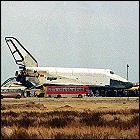 Russian President Boris Yeltsin brings an end to the secretive Soviet-era Buran project, which was the Soviet military’s answer to (and near-copy of) the American Space Shuttle fleet. Even though a second orbiter, Ptichka, is almost complete, and three others are in various stages of construction, Yeltsin and his advisors see no future for Buran and end the program as a cost-cutting measure. Due to its crash development and cost overruns, the Buran program has only launched a single unmanned shuttle on one orbital flight after the expenditure of the equivalent of $16,000,000,000.
Russian President Boris Yeltsin brings an end to the secretive Soviet-era Buran project, which was the Soviet military’s answer to (and near-copy of) the American Space Shuttle fleet. Even though a second orbiter, Ptichka, is almost complete, and three others are in various stages of construction, Yeltsin and his advisors see no future for Buran and end the program as a cost-cutting measure. Due to its crash development and cost overruns, the Buran program has only launched a single unmanned shuttle on one orbital flight after the expenditure of the equivalent of $16,000,000,000.
International Space Station narrowly avoids cancellation
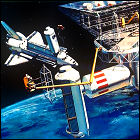 Despite plans having recently been expanded with international partnerships, including the Russian space program, the International Space Station comes within a single vote of being cancelled altogether in the United States House of Representatives. The measure to cancel the program is added to NASA’s authorization bill, which comes up for an annual vote; the measure is brought to the House floor by Indiana Democratic Rep. Tim Roemer and New Jersey Republican Rep. Richard Zimmer. Opposition to the space station comes in the form of budget concerns (the $9,000,000,000 already run up in research and construction is more than the total NASA expected to spend when it was directed to build, launch, and staff the station during the Reagan administration). Opponents of the station keep up their attempts to cancel it, however; a vote is later held for a bill that would strip NASA of station funding, effectively ending the program, and that vote also fails. The program survives by a wider margin in a later Senate vote as well. The same session of Congress does prove to be the end of another major scientific endeavour, the Superconducting Supercollider project already under construction in Texas.
Despite plans having recently been expanded with international partnerships, including the Russian space program, the International Space Station comes within a single vote of being cancelled altogether in the United States House of Representatives. The measure to cancel the program is added to NASA’s authorization bill, which comes up for an annual vote; the measure is brought to the House floor by Indiana Democratic Rep. Tim Roemer and New Jersey Republican Rep. Richard Zimmer. Opposition to the space station comes in the form of budget concerns (the $9,000,000,000 already run up in research and construction is more than the total NASA expected to spend when it was directed to build, launch, and staff the station during the Reagan administration). Opponents of the station keep up their attempts to cancel it, however; a vote is later held for a bill that would strip NASA of station funding, effectively ending the program, and that vote also fails. The program survives by a wider margin in a later Senate vote as well. The same session of Congress does prove to be the end of another major scientific endeavour, the Superconducting Supercollider project already under construction in Texas.
STS-57
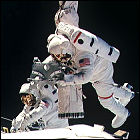 NASA launches Space Shuttle Endeavour on a mission lasting almost ten days to test the SPACEHAB pressurized lab module. A long-term exposure experiment is retrieved for ESA, though a spacewalk must be undertaken when its antennae fail to stow themselves away automatically for insertion into the cargo bay. Aboard Endeavour for her fourth flight into orbit are Commander Ronald Grabe, Pilot Brian Duffy, Payload Commander G. David Low, and mission specialists Nancy Sherlock, Peter Wisoff and Janice Voss.
NASA launches Space Shuttle Endeavour on a mission lasting almost ten days to test the SPACEHAB pressurized lab module. A long-term exposure experiment is retrieved for ESA, though a spacewalk must be undertaken when its antennae fail to stow themselves away automatically for insertion into the cargo bay. Aboard Endeavour for her fourth flight into orbit are Commander Ronald Grabe, Pilot Brian Duffy, Payload Commander G. David Low, and mission specialists Nancy Sherlock, Peter Wisoff and Janice Voss.
STS-55
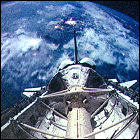 Space Shuttle Columbia lifts off on a mission lasting nearly ten days, carrying the Spacelab laboratory module in its cargo bay. This flight, Spacelab D-2, includes medical and material experiments, with one experiment controlled by an Apple Macintosh computer carried into orbit. Amateur radio messages are exchanged with the crew of the Mir space station. Aboard Columbia for her 14th flight are Commander Steven Nagel, Pilot Terence Henricks, mission specialists Jerry Ross, Charles Precourt and Bernard Harris Jr., and payload specialists Ulrich Walter and Hans Schlegel.
Space Shuttle Columbia lifts off on a mission lasting nearly ten days, carrying the Spacelab laboratory module in its cargo bay. This flight, Spacelab D-2, includes medical and material experiments, with one experiment controlled by an Apple Macintosh computer carried into orbit. Amateur radio messages are exchanged with the crew of the Mir space station. Aboard Columbia for her 14th flight are Commander Steven Nagel, Pilot Terence Henricks, mission specialists Jerry Ross, Charles Precourt and Bernard Harris Jr., and payload specialists Ulrich Walter and Hans Schlegel.
STS-56
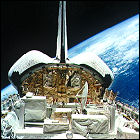 Space Shuttle Discovery lifts off with the ATLAS-2 scientific payload for a nine-day mission. A free-floating platform to measure solar wind activity is also deployed and then retrieved before returning to Earth. Aboard Discovery for her 16th flight are Commander Kenneth Cameron, Pilot Stephen Oswald, and mission specialists Michael Foale, Kenneth Cockrell and Ellen Ochoa.
Space Shuttle Discovery lifts off with the ATLAS-2 scientific payload for a nine-day mission. A free-floating platform to measure solar wind activity is also deployed and then retrieved before returning to Earth. Aboard Discovery for her 16th flight are Commander Kenneth Cameron, Pilot Stephen Oswald, and mission specialists Michael Foale, Kenneth Cockrell and Ellen Ochoa.
The International Space Station
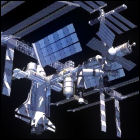 Having drawn the European Space Agency and Japan into partnerships for the still-on-the-drawing-board Space Station Freedom project, NASA announces that it is reaching out to post-Soviet Russia, not just for ideas and engineering expertise, but to become partners in the new space station. With already-built modules sitting on the ground for a Mir 2 station that it cannot afford to launch and operate on its own, Russia becomes a full partner in what will now become the International Space Station. Plans are accelerated for proposed missions to dock the Space Shuttle to the existing Mir space station, and to use Russian Soyuz capsules for crew transfer and return.
Having drawn the European Space Agency and Japan into partnerships for the still-on-the-drawing-board Space Station Freedom project, NASA announces that it is reaching out to post-Soviet Russia, not just for ideas and engineering expertise, but to become partners in the new space station. With already-built modules sitting on the ground for a Mir 2 station that it cannot afford to launch and operate on its own, Russia becomes a full partner in what will now become the International Space Station. Plans are accelerated for proposed missions to dock the Space Shuttle to the existing Mir space station, and to use Russian Soyuz capsules for crew transfer and return.
Soyuz TM-16: getting Mir ready for company
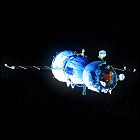 Cosmonauts Gennadi Manakov and Alexander Poleshchuk lift off aboard Soyuz TM-16, on a course for Russian space station Mir. In preparation for the upcoming joint international missions that will see American space shuttles docking with Mir, Soyuz TM-16 carries a new type of docking mechanism designed to test the docking port that will be used by visiting shuttles. Manakov and Poleshchuk remain aboard Mir for 179 days, returning to Earth in July 1993 with French spationaut Jean-Pierre Haigneré.
Cosmonauts Gennadi Manakov and Alexander Poleshchuk lift off aboard Soyuz TM-16, on a course for Russian space station Mir. In preparation for the upcoming joint international missions that will see American space shuttles docking with Mir, Soyuz TM-16 carries a new type of docking mechanism designed to test the docking port that will be used by visiting shuttles. Manakov and Poleshchuk remain aboard Mir for 179 days, returning to Earth in July 1993 with French spationaut Jean-Pierre Haigneré.
STS-54
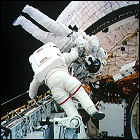 Space Shuttle Endeavour lifts off on the 53rd shuttle flight, a six-day mission to launch the fifth TDRS (Tracking & Data Relay Satellite) and perform assorted experiments. A five-hour spacewalk is conducted in the cargo bay to practice spacewalking techniques for future missions. Aboard Endeavour for her third flight are Commander John Casper, Pilot Donald McMonagle, and mission specialists Mario Runco, Gregory Harbaugh and Susan Helms.
Space Shuttle Endeavour lifts off on the 53rd shuttle flight, a six-day mission to launch the fifth TDRS (Tracking & Data Relay Satellite) and perform assorted experiments. A five-hour spacewalk is conducted in the cargo bay to practice spacewalking techniques for future missions. Aboard Endeavour for her third flight are Commander John Casper, Pilot Donald McMonagle, and mission specialists Mario Runco, Gregory Harbaugh and Susan Helms.
STS-53
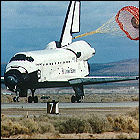 Space Shuttle Discovery lifts off on the 52nd shuttle flight, a seven-day mission to deploy a classified Department of Defense payload and conduct various science experiments within the shuttle itself. Flying Discovery on its 15th launch are Commander David Walker, Pilot Robert Cabana, and mission specialists Guion Bluford, James Voss and Michael Clifford.
Space Shuttle Discovery lifts off on the 52nd shuttle flight, a seven-day mission to deploy a classified Department of Defense payload and conduct various science experiments within the shuttle itself. Flying Discovery on its 15th launch are Commander David Walker, Pilot Robert Cabana, and mission specialists Guion Bluford, James Voss and Michael Clifford.
STS-52
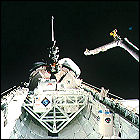 Space Shuttle Columbia lifts off on the shuttle program’s 51st flight, a ten-day mission to launch Laser Geodynamic Satellite II and the cargo-bay-mounted U.S. Microgravity Payload experiment package. Aboard Columbia for her 13th flight are Commander James Wetherbee, Pilot Michael Baker, mission specialists Charles Veach, William Shepherd and Tamara Jernigan, and payload specialist Steven MacLean.
Space Shuttle Columbia lifts off on the shuttle program’s 51st flight, a ten-day mission to launch Laser Geodynamic Satellite II and the cargo-bay-mounted U.S. Microgravity Payload experiment package. Aboard Columbia for her 13th flight are Commander James Wetherbee, Pilot Michael Baker, mission specialists Charles Veach, William Shepherd and Tamara Jernigan, and payload specialist Steven MacLean.
STS-47
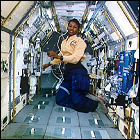 Space Shuttle Endeavour lifts off on the 50th space shuttle mission (and its own first return flight to orbit). Carrying the Spacelab module in its cargo bay, Endeavour hosts the first Japanese shuttle astronaut and the first African-American woman in space. Over eight days, the crew performs various science experiments. Endeavour is flown by Commander Robert “Hoot” Gibson, Pilot Curtis Brown, Payload Commander Mark Lee, missions specialists Jan Davis, Jay Apt and Mae Jemison, and payload specialist Mamoru Mohri.
Space Shuttle Endeavour lifts off on the 50th space shuttle mission (and its own first return flight to orbit). Carrying the Spacelab module in its cargo bay, Endeavour hosts the first Japanese shuttle astronaut and the first African-American woman in space. Over eight days, the crew performs various science experiments. Endeavour is flown by Commander Robert “Hoot” Gibson, Pilot Curtis Brown, Payload Commander Mark Lee, missions specialists Jan Davis, Jay Apt and Mae Jemison, and payload specialist Mamoru Mohri.
STS-46
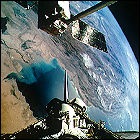 Space Shuttle Atlantis is launched on an eight-day mission to deploy two experiment packages developed jointly with the European and Italian space agencies. (The mission is extended by a day to accomodate more experiments.) Aboard Atlantis for her 12th flight are Commander Loren Shriver, Pilot Andrew Allen, mission specialists Jeffrey Hoffman, Franklin Chang-Diaz, Claude Nicollier and Marsha Ivins, and payload specialist Franco Malerba.
Space Shuttle Atlantis is launched on an eight-day mission to deploy two experiment packages developed jointly with the European and Italian space agencies. (The mission is extended by a day to accomodate more experiments.) Aboard Atlantis for her 12th flight are Commander Loren Shriver, Pilot Andrew Allen, mission specialists Jeffrey Hoffman, Franklin Chang-Diaz, Claude Nicollier and Marsha Ivins, and payload specialist Franco Malerba.
Soyuz TM-15
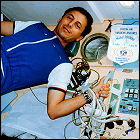 The Russian spacecraft Soyuz TM-15 lifts off from Kazakhstan, carrying cosmonauts Anatoly Solovyev and Sergei Avdeyev, along with French spationaut Michel Tognini, to space station Mir. Tognini remains aboard Mir for two weeks, returning with the Soyuz TM-14 crew, while Solovyev and Avdeyev are aboard for the long haul, manning Mir for 188 days before returning to Earth early in 1993.
The Russian spacecraft Soyuz TM-15 lifts off from Kazakhstan, carrying cosmonauts Anatoly Solovyev and Sergei Avdeyev, along with French spationaut Michel Tognini, to space station Mir. Tognini remains aboard Mir for two weeks, returning with the Soyuz TM-14 crew, while Solovyev and Avdeyev are aboard for the long haul, manning Mir for 188 days before returning to Earth early in 1993.
STS-50
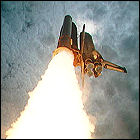 NASA launches Space Shuttle Columbia on the 48th shuttle mission (Columbia’s 12th trip into orbit). Using the Spacelab module, Columbia’s crew conducted the first USML (United States Microgravity Laboratory) flight, as well as testing a new system called the EDO (Extended Duration Orbiter) package, allowing the crew to stay in orbit longer than any previous shuttle (or, for that matter, lunar) flight. Aboard Columbia for the record-breaking 13-and-a-half-day mission are Commander Richard N. Richards, Pilot Ken Bowersox, Payload Commander Bonnie Dunbar, mission specialists Ellen Baker and Carl Meade, and payload specialists Lawrence DeLucasand Eugene Trinh.
NASA launches Space Shuttle Columbia on the 48th shuttle mission (Columbia’s 12th trip into orbit). Using the Spacelab module, Columbia’s crew conducted the first USML (United States Microgravity Laboratory) flight, as well as testing a new system called the EDO (Extended Duration Orbiter) package, allowing the crew to stay in orbit longer than any previous shuttle (or, for that matter, lunar) flight. Aboard Columbia for the record-breaking 13-and-a-half-day mission are Commander Richard N. Richards, Pilot Ken Bowersox, Payload Commander Bonnie Dunbar, mission specialists Ellen Baker and Carl Meade, and payload specialists Lawrence DeLucasand Eugene Trinh.
STS-49: Endeavour’s first flight
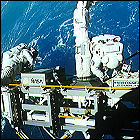 Space Shuttle Endeavour leaves Earth for the first time, carrying a crew of seven to orbit on the 47th shuttle mission. Over nearly nine days, three spacewalks are taken up with the tricky and dangerous task of capturing a four-and-a-half-ton communications satellite into Endeavour’s cargo bay to repair and relaunch it. (The satellite, Intelsat VI, had been stranded in the wrong orbit since its 1990 launch aboard a Titan rocket.) The record-setting spacewalks involved – each lasting over seven hours and marking the first time three astronauts have operated outside their vehicle – force NASA to cancel one of two experimental EVAs to test space station construction techniques. Endeavour’s first crew consists of Commander Daniel Brandenstein, pilot Kevin Chilton, and mission specialists Pierre Thuot, Kathryn Thornton, Richard Hieb, Thomas Akers and Bruce Melnick.
Space Shuttle Endeavour leaves Earth for the first time, carrying a crew of seven to orbit on the 47th shuttle mission. Over nearly nine days, three spacewalks are taken up with the tricky and dangerous task of capturing a four-and-a-half-ton communications satellite into Endeavour’s cargo bay to repair and relaunch it. (The satellite, Intelsat VI, had been stranded in the wrong orbit since its 1990 launch aboard a Titan rocket.) The record-setting spacewalks involved – each lasting over seven hours and marking the first time three astronauts have operated outside their vehicle – force NASA to cancel one of two experimental EVAs to test space station construction techniques. Endeavour’s first crew consists of Commander Daniel Brandenstein, pilot Kevin Chilton, and mission specialists Pierre Thuot, Kathryn Thornton, Richard Hieb, Thomas Akers and Bruce Melnick.
STS-45
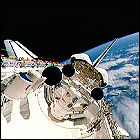 NASA launches Space Shuttle Atlantis on the 46th shuttle mission, carrying the Spacelab-based ATLAS (Atmospheric Laboratory for Applications and Science) experiment module. Aboard Atlantis for the nearly-nine-day flight are Commander Charles Bolden, Pilot Brian Duffy, Payload Commander Kathyrn Sullivan, mission specialists David Leestma and Michael Foale, and payload specialists Byron Lichtenberg and Dirk Frimout. NASA extends the mission by one day to accomodate additional experiments.
NASA launches Space Shuttle Atlantis on the 46th shuttle mission, carrying the Spacelab-based ATLAS (Atmospheric Laboratory for Applications and Science) experiment module. Aboard Atlantis for the nearly-nine-day flight are Commander Charles Bolden, Pilot Brian Duffy, Payload Commander Kathyrn Sullivan, mission specialists David Leestma and Michael Foale, and payload specialists Byron Lichtenberg and Dirk Frimout. NASA extends the mission by one day to accomodate additional experiments.
Soyuz TM-14: Russia in space
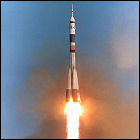 Soyuz TM-14 lifts off from the Baikonur Cosmodrome in Kazakhstan, the first space mission from post-Soviet Russia. It carries cosmonauts Alexander Viktorenko, Alexander Kaleri, and Klaus-Dietrich Flade to space station Mir. Viktorenko and Kaleri remain aboard Mir for 145 days, while Flade returns to Earth with the previous station crew aboard Soyuz TM-13. When TM-14 returns to Earth in August 1992, Viktorenko and Kaleri suffer an unusual landing, with their descent module rolling to an upside-down position, trapping the cosmonauts inside until rescue crews arrive.
Soyuz TM-14 lifts off from the Baikonur Cosmodrome in Kazakhstan, the first space mission from post-Soviet Russia. It carries cosmonauts Alexander Viktorenko, Alexander Kaleri, and Klaus-Dietrich Flade to space station Mir. Viktorenko and Kaleri remain aboard Mir for 145 days, while Flade returns to Earth with the previous station crew aboard Soyuz TM-13. When TM-14 returns to Earth in August 1992, Viktorenko and Kaleri suffer an unusual landing, with their descent module rolling to an upside-down position, trapping the cosmonauts inside until rescue crews arrive.
STS-42
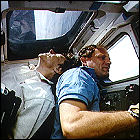 Space Shuttle Discovery lifts off for an eight day Spacelab mission, with an multi-national crew participating in “IML-1” (International Microgravity Laboratory) experiments. Discovery’s crew for this flight consists of Commander Ronald Grabe, Pilot Stephen Oswald, mission specialists Norman Thagard, David Hilmers, and William Readdy, and payload specialists Roberta Bondar and Ulf Merbold.
Space Shuttle Discovery lifts off for an eight day Spacelab mission, with an multi-national crew participating in “IML-1” (International Microgravity Laboratory) experiments. Discovery’s crew for this flight consists of Commander Ronald Grabe, Pilot Stephen Oswald, mission specialists Norman Thagard, David Hilmers, and William Readdy, and payload specialists Roberta Bondar and Ulf Merbold.
STS-44
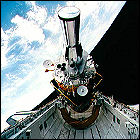 NASA launches Space Shuttle Atlantis on a mission lasting nearly a week, deploying both classified and unclassified payloads for the Defense Department. After the payload deployments, tests are conducted to determine the viability of the shuttle orbiters for long-duration missions. Manning Atlantis for this mission are Commander Frederick Gregory, Pilot Terence Henricks, and mission specialists Mario Runco, James Voss, Story Musgrave and Thomas Hennen.
NASA launches Space Shuttle Atlantis on a mission lasting nearly a week, deploying both classified and unclassified payloads for the Defense Department. After the payload deployments, tests are conducted to determine the viability of the shuttle orbiters for long-duration missions. Manning Atlantis for this mission are Commander Frederick Gregory, Pilot Terence Henricks, and mission specialists Mario Runco, James Voss, Story Musgrave and Thomas Hennen.
Soyuz TM-13: the last Soviet space mission
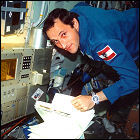 The Soviet Union launches its last space mission, Soyuz TM-13, carrying cosmonauts Alexander Volkov, Toktar Aubakirov and the first Austrian in space, Franz Viehböck, to space station Mir. After a week in space, Aubakirov and Viehböck return to Earth aboard Soyuz TM-12 with incumbent station crewmember Anatoly Artsebarksky, while Volkov stays for 175 days (alongside Krikalev, who will have been in space for 10 months by the time he returns to Earth in 1992). During Volkov and Krikalev’s stay aboard Mir, the Soviet Union collapses; they instead return to Earth as Russian citizens.
The Soviet Union launches its last space mission, Soyuz TM-13, carrying cosmonauts Alexander Volkov, Toktar Aubakirov and the first Austrian in space, Franz Viehböck, to space station Mir. After a week in space, Aubakirov and Viehböck return to Earth aboard Soyuz TM-12 with incumbent station crewmember Anatoly Artsebarksky, while Volkov stays for 175 days (alongside Krikalev, who will have been in space for 10 months by the time he returns to Earth in 1992). During Volkov and Krikalev’s stay aboard Mir, the Soviet Union collapses; they instead return to Earth as Russian citizens.
 using WordPress and
using WordPress and